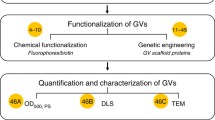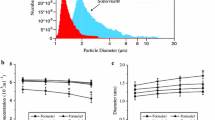Abstract
Purpose
Ultrasound contrast agent (UCA), used to enhance the contrast in ultrasonography, consists of microbubbles filled with an inert gas and encapsulated with a protein or a lipidic-stabilize membrane. The UCAs are able to resonate when exposed to ultrasound waves and to generate an echo-acoustic signal with increased intensity. Recently, a technique to produce UCA from microorganisms was developed and it consists of lysing microorganism cells to obtain gas vesicle (GV) after cultivation in the laboratory. GVs occur almost exclusively in aquatic microorganisms, as Microcystis aeruginosa (MYC), and provide buoyancy which permit to float towards the water surface. This work implemented a technique to produce GVs from MYC, at the Ultrasound Laboratory, and inspected their properties of acting as UCAs, analyzed through ultrasonic images acquired at 40 MHz, and their structural characteristics such as morphology, diameter, and length.
Methods
After the cultivation of MYC, the buoyant cells with GVs were separated from the culture medium and submitted to cell lysis with chemical treatment. Thereafter, the solution with lysed cells was centrifuged, at 300g during 8 h at 4–8 °C, to isolate the GVs (absorbance 0.6, λ = 500 nm).
Results
Transmission electron microscopy inspection revealed the MYC-GVs with elliptical morphology and having a diameter between 100 and 150 nm and length near to 200 nm. B-mode ultrasound images of the solutions proved the GV’s ability to generate an echo signal, thus confirming their performance as UCAs.





Similar content being viewed by others
References
Achmad A, Yamaguchi A, Hanaoka H, et al. Thin-shelled PEGylated Perfluorooctyl bromide nanocapsules for tumor-targeted ultrasound contrast agent. Contrast Media Mol Imaging. 2018;2018:1–11. https://doi.org/10.1155/2018/1725323.
Chomas JE, Dayton P, May D, et al. Threshold of fragmentation for ultrasonic contrast agents. J Biomed Opt. 2001;6(2):141. https://doi.org/10.1117/1.1352752.
Chorus I, Bartram J (Org.). Toxic cyanobacteria in water: a guide to their public health consequences, monitoring, and management. London ; New York: E & FN Spon; 1999.
Ferrara K, Pollard R, Borden M. Ultrasound microbubble contrast agents: fundamentals and application to gene and drug delivery. Annu Rev Biomed Eng. 2007;9(1):415–47. https://doi.org/10.1146/annurev.bioeng.8.061505.095852.
Gorbenko GP, Ioffe VM, Kinnunen PKJ. Binding of lysozyme to phospholipid bilayers: evidence for protein aggregation upon membrane association. Biophys J. 2007;93(1):140–53. https://doi.org/10.1529/biophysj.106.102749.
Gorham PR, Mclachlan J, Hammer UT, et al. Isolation and culture of toxic strains of Anabaena flos-aquae (Lyngb.) de Bréb. SIL Proc, 1922–2010. 1964;15(2):796–804. https://doi.org/10.1080/03680770.1962.11895606.
Gramiak R, Shah PM, Kramer DH. Ultrasound cardiography: contrast studies in anatomy and function. Radiology. 1969;92(5):939–48. https://doi.org/10.1148/92.5.939.
Griffiths AE, Walsby AE, Hayes PK. The homologies of gas vesicle proteins. J Gen Microbiol. 1992;138(6):1243–50. https://doi.org/10.1099/00221287-138-6-1243.
Güvener N, Appold L, DE Lorenzi F, et al. Recent advances in ultrasound-based diagnosis and therapy with micro- and nanometer-sized formulations. Methods. 2017;130:4–13. https://doi.org/10.1016/j.ymeth.2017.05.018.
Hashizume H, Baluk P, Morikawa S, et al. Openings between defective endothelial cells explain tumor vessel leakiness. Am J Pathol. 2000;156(4):1363–80. https://doi.org/10.1016/S0002-9440(10)65006-7.
Hernot S, Klibanov AL. Microbubbles in ultrasound-triggered drug and gene delivery. Adv Drug Deliv Rev. 2008;60(10):1153–66. https://doi.org/10.1016/j.addr.2008.03.005.
Hunt D, Romero J. Contrast-enhanced ultrasound. Magn Reson Imaging Clin N Am. 2017;25(4):725–36. https://doi.org/10.1016/j.mric.2017.06.004.
Kim J-S, Park Y-H, Yoon B-D, et al. Note establishment of axenic cultures of Anabaena flos-aquae and Aphanothece nidulans (cyanobacteria) by lysozyme treatment. J Phycol. 1999;35(4):865–9. https://doi.org/10.1046/j.1529-8817.1999.3540865.x.
Lakshmanan A, Lu GJ, Farhadi A, et al. Preparation of biogenic gas vesicle nanostructures for use as contrast agents for ultrasound and MRI. Nat Protoc. 2017;12(10):2050–80. https://doi.org/10.1038/nprot.2017.081.
Lehmann H, Jost M. Kinetics of the assembly of gas vacuoles in the blue-green alga Microcystis aeruginosa Kuetz. emend. Elekin. Arch Mikrobiol. 1971;79(1):59–68. https://doi.org/10.1007/BF00412041.
Mehta KK, Evitt NH, Swartz JR. Chemical lysis of cyanobacteria. J Biol Eng. 2015;9(1):10. https://doi.org/10.1186/s13036-015-0007-y.
Oddo L, Cerroni B, Domenici F, et al. Next generation ultrasound platforms for theranostics. J Colloid Interface Sci. 2017;491:151–60. https://doi.org/10.1016/j.jcis.2016.12.030.
Pfeifer F. Distribution, formation and regulation of gas vesicles. Nat Rev Microbiol. 2012;10(10):705–15. https://doi.org/10.1038/nrmicro2834.
Raisinghani A, Demaria AN. Physical principles of microbubble ultrasound contrast agents. Am J Cardiol. 2002;90(10):3–7. https://doi.org/10.1016/S0002-9149(02)02858-8.
Robertson PKJ, Lawton LA, Cornish BJPA. The involvement of phycocyanin pigment in the photodecomposition of the cyanobacterial toxin, Microcystin-LR. J Porphyrins Phthalocyanines. 1999;03(07):544–51. https://doi.org/10.1002/(SICI)1099-1409(199908/10)3:6/7<544::AID-JPP173>3.0.CO;2-7.
Shapiro MG, Goodwill PW, Neogy A, et al. Biogenic gas nanostructures as ultrasonic molecular reporters. Nat Nanotechnol. 2014;9(4):311–6. https://doi.org/10.1038/nnano.2014.32.
Soletti RC, DE Britto MAP, Borges HL, et al. Detection of mice colorectal tumors by endoluminal ultrasound biomicroscopic images and quantification of image augmented gray values following injection of VEGFR-2 targeted contrast agent. Acad Radiol. Published online: February 14. 2020. https://doi.org/10.1016/j.acra.2020.01.013.
Tanabe Y, Yamaguchi H. Evolutionary history of phycoerythrin pigmentation in the water bloom-forming cyanobacterium Microcystis aeruginosa. 2018. https://doi.org/10.1101/485508.
Tortora GJ, Funke BR, Case CL Microbiology: an introduction. 10th ed., Artmed Editora SA, Copyright ©; 2012.
Vanosdol J, Ektate K, Ramasamy S, et al. Sequential HIFU heating and nanobubble encapsulation provide efficient drug penetration from stealth and temperature sensitive liposomes in colon cancer. J Control Release. 2017;247:55–63. https://doi.org/10.1016/j.jconrel.2016.12.033.
Visser PM, Passarge J, Mur LR. Modelling vertical migration of the cyanobacterium Microcystis. Hydrobiologia. 1997;349(1/3):99–109. https://doi.org/10.1023/A:1003001713560.
Walsby AE. Gas vesicles, microbiological reviews. Am Soc Microbiol. 1994;58(1):94–144.
Walsby AE, Hayes PK. The minor cyanobacterial gas vesicle protein, GVPc, is attached to the outer surface of the gas vesicle. Microbiology. 1988;134(10):2647–57. https://doi.org/10.1099/00221287-134-10-2647.
Wheatley MA, Cochran M. Ultrasound contrast agents. J Drug Deliv Sci Technol. 2013;23(1):57–72. https://doi.org/10.1016/S1773-2247(13)50007-4.
Yang Y, Qiu Z, Hou X, et al. Ultrasonic characteristics and cellular properties of Anabaena gas vesicles. Ultrasound Med Biol. 2017;43(12):2862–70. https://doi.org/10.1016/j.ultrasmedbio.2017.08.004.
Yuan F, Dellian M, Fukumura D, et al. Vascular permeability in a human tumor xenograft: molecular size dependence and cutoff size. Cancer Res. 1995;55:6.
Acknowledgments
The authors thank the collaboration from Cyanobacteria Ecophysiology and Toxicology Laboratory (LETC), from Carlos Chagas Filho Biophysics Institute from Federal University of Rio de Janeiro (UFRJ).
Funding
This study was financially supported by the National Council for Scientific and Technological Development (CNPq), the Brazilian Federal Agency for Support and Evaluation of Higher Education (CAPES), and the Carlos Chagas Filho Foundation for Research Support of the State of Rio de Janeiro (FAPERJ).
Author information
Authors and Affiliations
Corresponding author
Ethics declarations
Conflict of interest
The authors declare that they have no conflict of interest.
Additional information
Publisher’s note
Springer Nature remains neutral with regard to jurisdictional claims in published maps and institutional affiliations.
Rights and permissions
About this article
Cite this article
Garrute, F.V., Machado, J.C. Gas vesicle isolated from microorganisms to act as ultrasound contrast agent. Res. Biomed. Eng. 37, 1–7 (2021). https://doi.org/10.1007/s42600-020-00093-5
Received:
Accepted:
Published:
Issue Date:
DOI: https://doi.org/10.1007/s42600-020-00093-5




